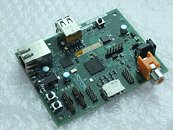
Creative ZiiLabs Announces 100 Core CPU
ZiiLABS, a pioneering media processor and platforms company (a wholly-owned subsidiary of Creative Technology Ltd), today unveiled its ground-breaking 100-core ZMS-40 StemCell Media processor optimized for Android. The ZMS-40 combines 96 of ZiiLABS' StemCell media processing cores with four 1.5GHz ARM Cortex-A9 CPUs to deliver stunning multi-tasking application and media processing performance.
By doubling the number of StemCell Media processors compared to the previous ZMS-20, the ZMS-40 delivers twice the peak media performance, while running the larger array at lower clock speeds to achieve the same performance leads to greater energy efficiency and a reduction in power consumption of up to 50 percent. With 2X the performance and 2X the power efficiency, the ZMS-40 delivers ground-breaking media capabilities to handheld devices such as tablets, including ultra-high-resolution H.264 HP decoding of up to 3840x1080 for true 1080p 3D stereo, a rich and interactive desktop browsing experience, 2560x1600 (WQXGA) display resolution support, higher-quality video encoding and immersive OpenGL ES graphics and future support for High Efficiency Video Coding (HEVC).
By doubling the number of StemCell Media processors compared to the previous ZMS-20, the ZMS-40 delivers twice the peak media performance, while running the larger array at lower clock speeds to achieve the same performance leads to greater energy efficiency and a reduction in power consumption of up to 50 percent. With 2X the performance and 2X the power efficiency, the ZMS-40 delivers ground-breaking media capabilities to handheld devices such as tablets, including ultra-high-resolution H.264 HP decoding of up to 3840x1080 for true 1080p 3D stereo, a rich and interactive desktop browsing experience, 2560x1600 (WQXGA) display resolution support, higher-quality video encoding and immersive OpenGL ES graphics and future support for High Efficiency Video Coding (HEVC).






